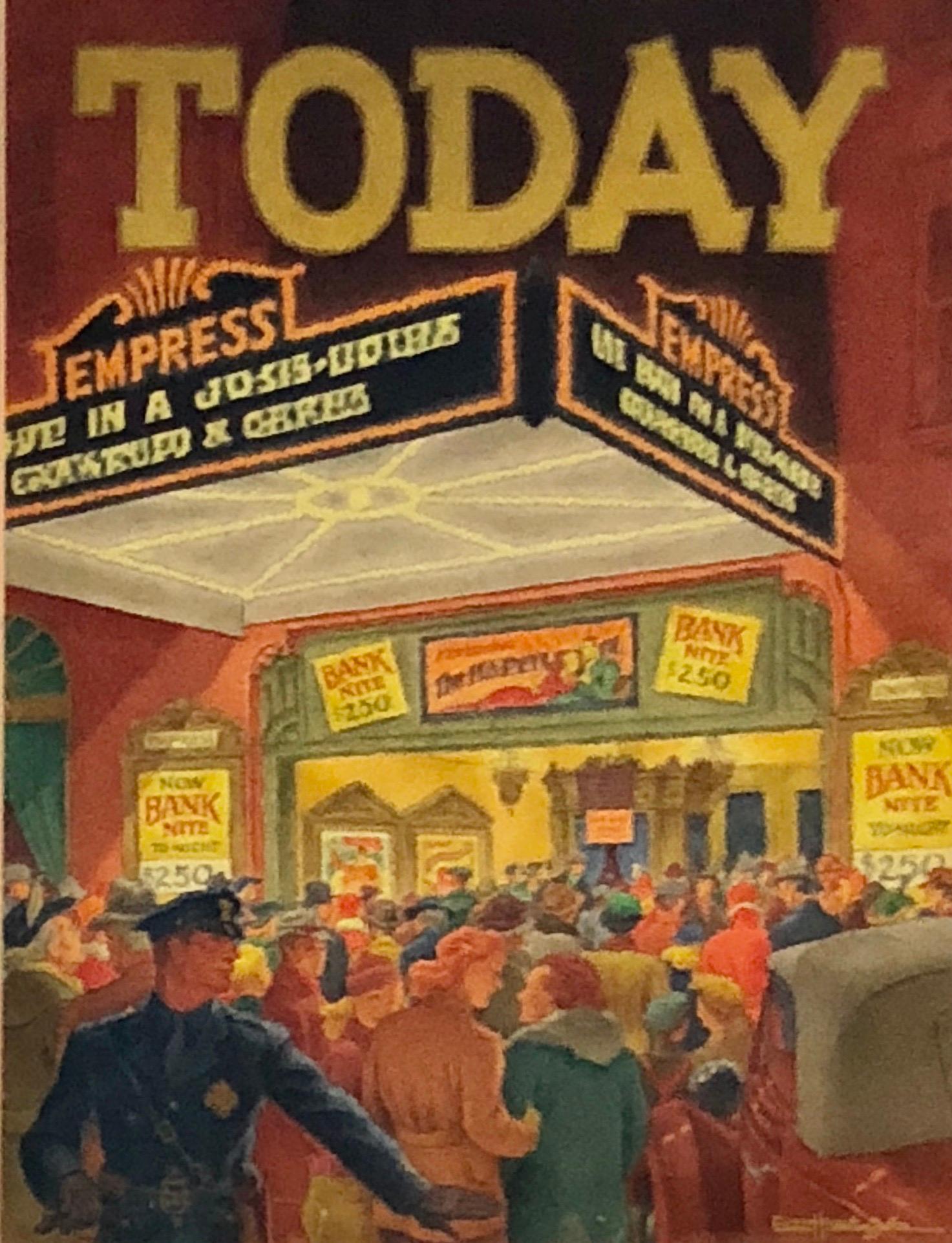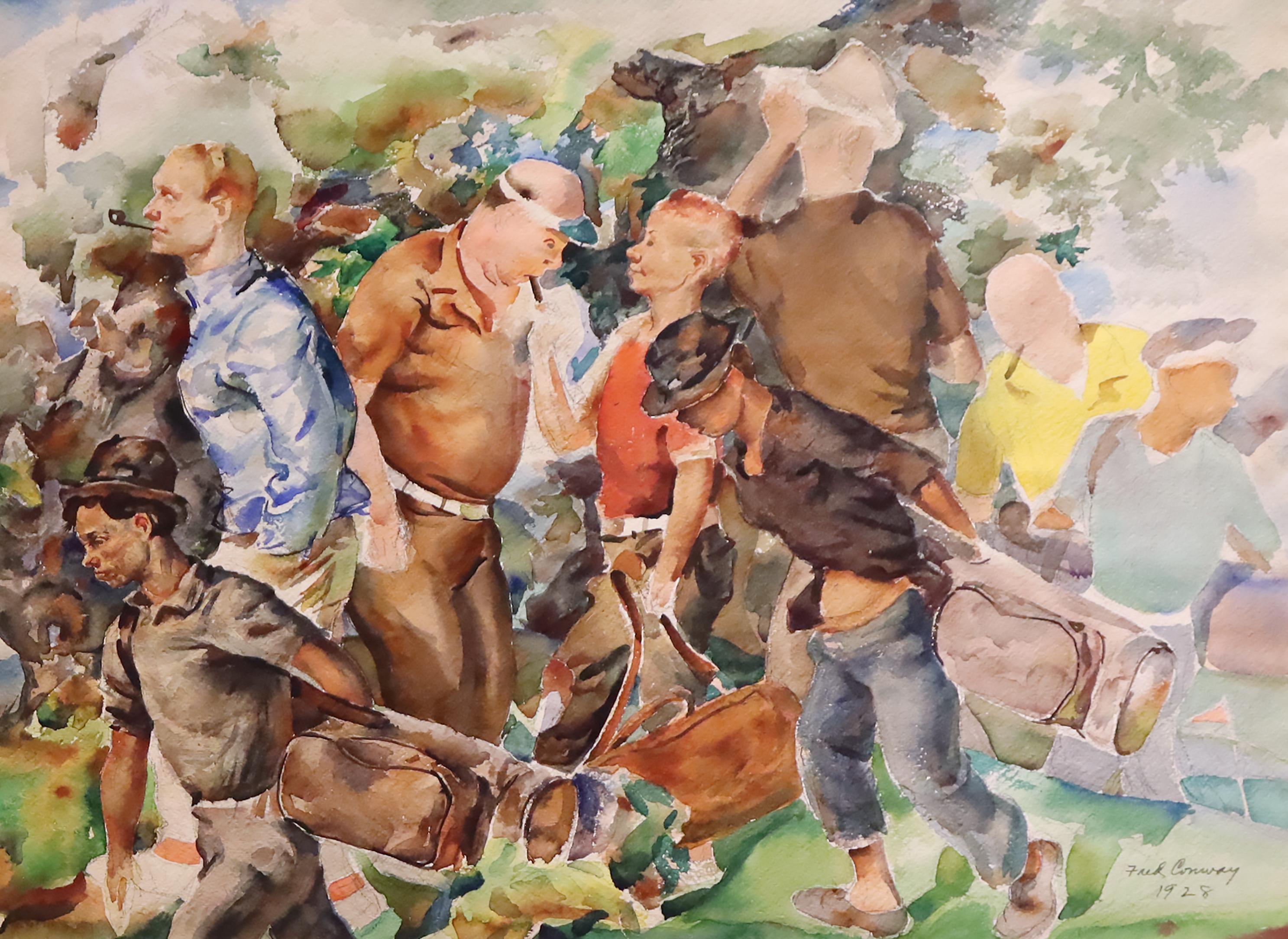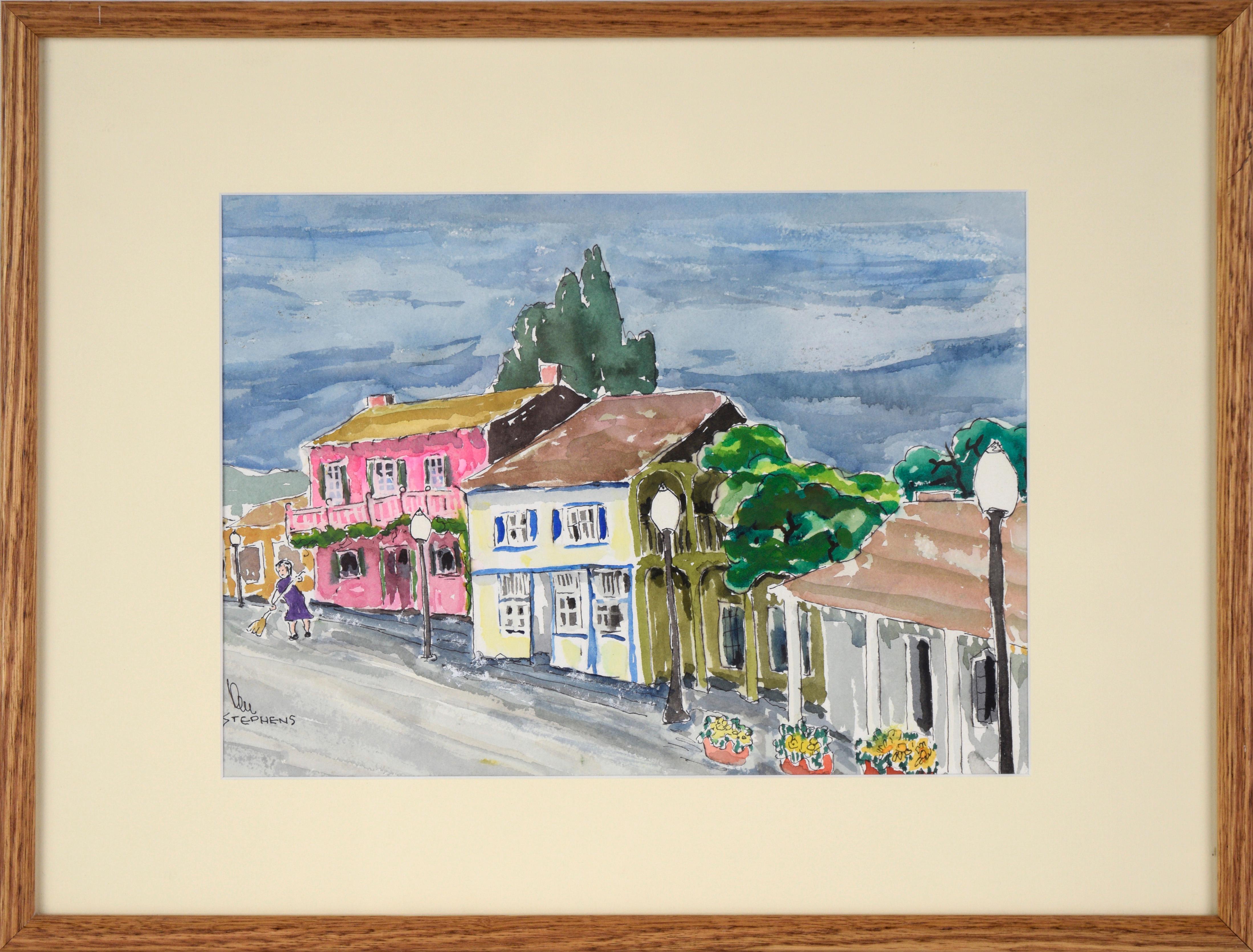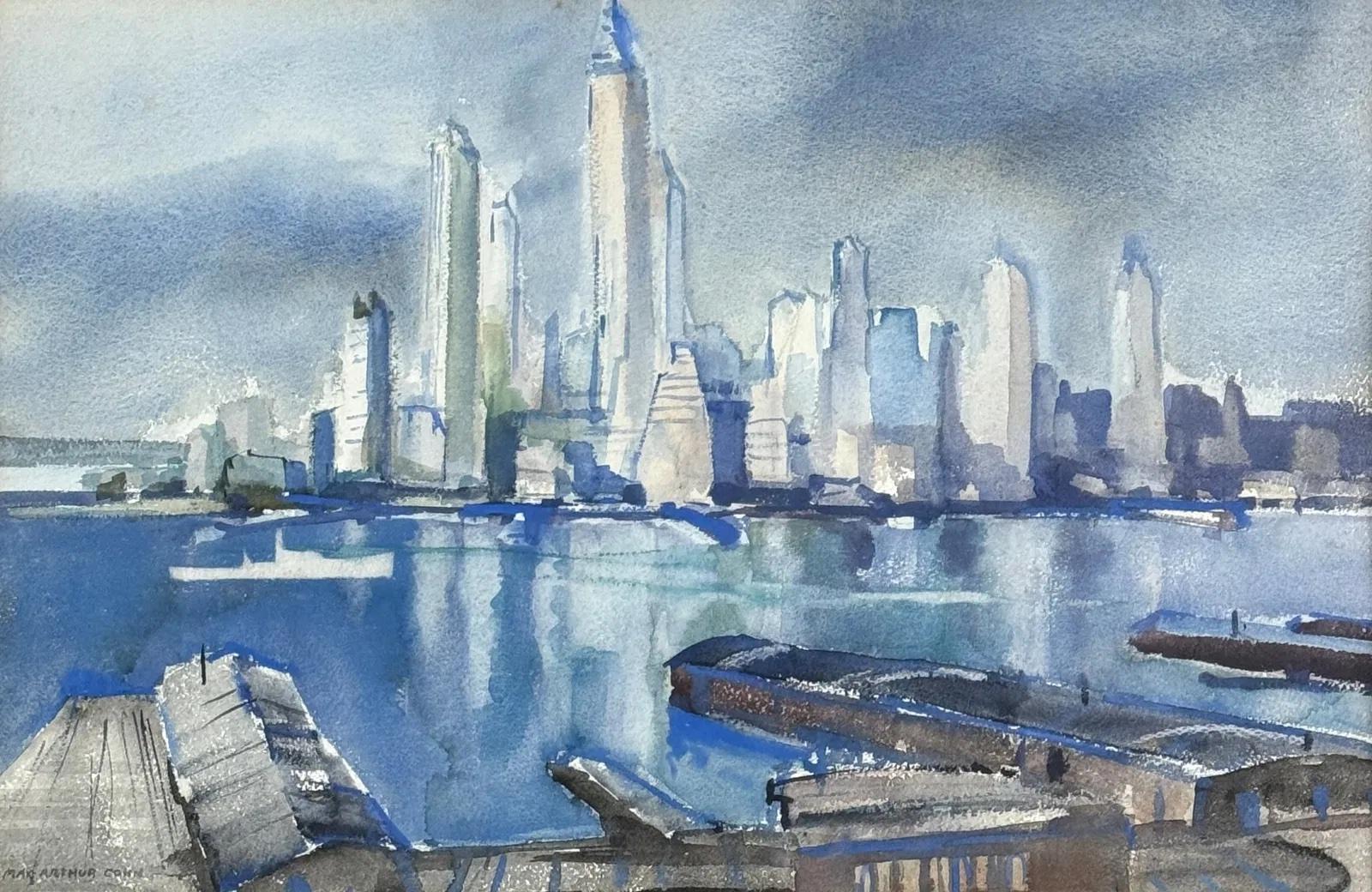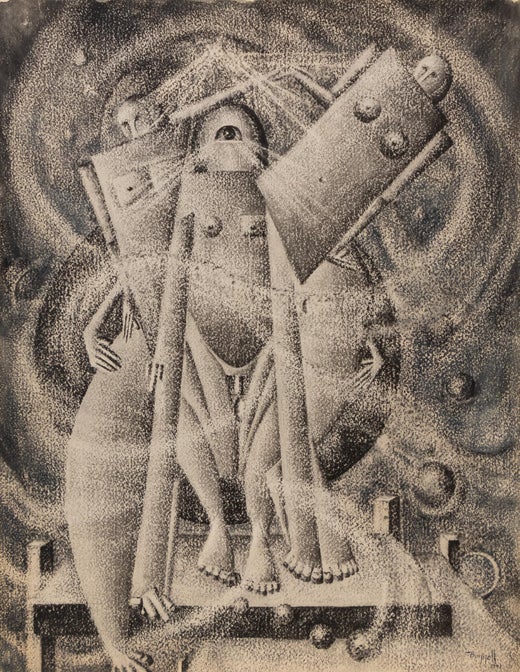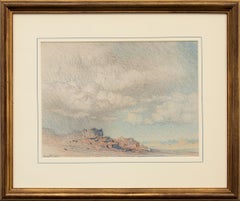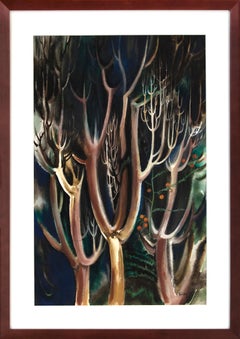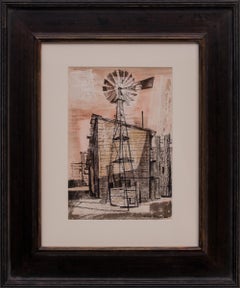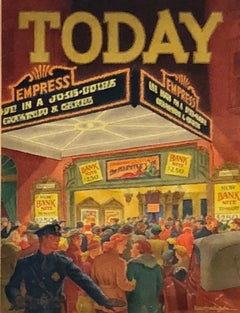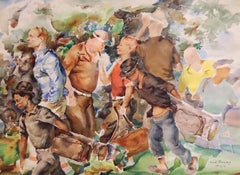Items Similar to WPA 1940s Framed Figurative Village Landscape with Figures Houses Mountains
Want more images or videos?
Request additional images or videos from the seller
1 of 16
Charles Ragland BunnellWPA 1940s Framed Figurative Village Landscape with Figures Houses Mountains1940
1940
About the Item
Depression era watercolor painting by Charles Ragland Bunnell (1897-1968) titled "The Way War First Comes" from 1940 of an outdoor village scene. Presented in a custom black frame with archival materials, outer dimensions measure 26 x 35 ½ x ⅝ inches. Image size is 15 ¼ x 24 ⅝ inches.
Painting is clean and in very good vintage condition - please contact us for a detailed condition report.
Provenance: Private collection, Colorado
Expedited and international shipping is available - please contact us for a quote.
About the Artist:
Artist and teacher, Charles (“Charlie”) Bunnell worked in a variety of styles throughout his career because as an artist he believed, “I’ve got to paint a thousand different ways. I don’t paint any one way.” At different times he did representational landscapes while concurrently involved with semi- or completely abstract imagery. He was one of a relatively small number of artists in Colorado successfully incorporating into their work the new trends emanating from New York and Europe after World War II. During his lifetime he generally did not attract a great deal of critical attention from museums, critics and academia. However, he personally experienced a highpoint in his career when Katherine Kuh, curator at the Art Institute of Chicago, personally chose one of his paintings – Why? - for its large exhibition of several hundred examples of abstract and surrealist art held in 1947-48, subsequently including it among the fifty pieces selected for a traveling show to ten other American museums.
An only child, Bunnell developed his love of art at a young age through frequent drawing and political cartooning. In high school he was interested in baseball and golf and also was the tennis champion for Westport High School in Kansas City. Following graduation, his father moved the family to Denver, Colorado, in 1916 for a better-paying bookkeeping job, before relocating the following year to Colorado Springs to work for local businessman, Edmond C. van Diest, President of the Western Public Service Company and the Colorado Concrete Company. Bunnell would spend almost all of his adult life in Colorado Springs.
In 1918 he enlisted in the United States Army, serving in the 62nd Infantry Regiment through the end of World War I. Returning home with a 10% disability, he joined the Zebulon Pike Post No. 1 of the Disabled American Veterans Association and in 1921 used the benefits from his disability to attend a class in commercial art design conducted under a government program in Colorado Springs. The following year he transferred to the Broadmoor Art Academy (founded in 1919) where he studied with William Potter and in 1923 with Birger Sandzén. Sandzén’s influence is reflected in Bunnell’s untitled Colorado landscape (1925) with a bright blue-rose palette.
For several years thereafter Bunnell worked independently until returning to the Broadmoor Art Academy to study in 1927-28 with Ernest Lawson, who previously taught at the Kansas City Art Institute where Bunnell himself later taught in the summers of 1929-1930 and in 1940-41. Lawson, a landscapist and colorist, was known for his early twentieth-century connection with “The Eight” in New York, a group of forward-looking painters including Robert Henri and John Sloan whose subject matter combined a modernist style with urban-based realism. Bunnell, who won first-place awards in Lawson’s landscapes classes at the Academy, was promoted to his assistant instructor for the figure classes in the 1928-29 winter term. Lawson, who painted in what New York critic James Huneker termed a “crushed jewel” technique, enjoyed additional recognition as a member of the Committee on Foreign Exhibits that helped organize the landmark New York Armory Exhibition in 1913 in which Lawson showed and which introduced European avant-garde art to the American public.
As noted in his 1964 interview for the Archives of American Art in Washington, DC, Bunnell learned the most about his teacher’s use of color by talking with him about it over Scotch as his assistant instructor. “Believe me,” Bunnell later said, “[Ernie] knew color, one of the few Americans that did.” His association with Lawson resulted in local scenes of Pikes Peak, Eleven Mile Canyon, the Gold Cycle Mine near Colorado City and other similar sites, employing built up pigments that allowed the surfaces of his canvases to shimmer with color and light. (Eleven Mile Canyon was shown in the annual juried show at the Carnegie Institute in Pittsburgh in 1928, an early recognition of his talent outside of Colorado.) At the same time, he animated his scenes of Colorado Springs locales by defining the image shapes with color and line as demonstrated in Contrasts (1929). Included in the Midwestern Artists’ Exhibition in Kansas City in 1929, it earned him the gold medal of the Kansas City Art Institute, auguring his career as a professional artist.
In the 1930s Bunnell used the oil, watercolor and lithography media to create a mini-genre of Colorado’s old mining towns and mills, subject matter spurned by many local artists at the time in favor of grand mountain scenery. In contrast to his earlier images, these newer ones – both daytime and nocturnal -- such as Blue Bird Mine essentially are form studies. The conical, square and rectangular shapes of the buildings and other structures are placed in the stark, undulating terrain of the mountains and valleys devoid of any vegetation or human presence. In the mid-1930s he also used the same approach in his monochromatic lithographs titled Evolution, Late Evening, K.C. (Kansas City) and The Mill, continuing it into the next decade with his oil painting, Pikes Peak (1942).
During the early 1930s he studied for a time with Boardman Robinson, director of the Broadmoor Art Academy and its successor institution, the Colorado Springs Fine Arts Center from 1930 to 1947. In 1934 Robinson gave him the mural commission under the Public Works of Art Project (PWAP) for West Junior High School in Colorado Springs, his first involvement in one of several New Deal art projects employing artists during the Great Depression. He thereafter assisted Frank Mechau with his mural for the Colorado Springs Post Office and Mechau, in turn, helped get him transferred to the Treasury Relief Art Project (TRAP) that commissioned work from artists to decorate existing and new federal buildings throughout the country. When it closed down due to lack of funds, Bunnell participated in the Federal Art Project (FAP) for which he did easel paintings in the proscribed American Scene painting style.
At the same time, he also began working on his own in a non-regionalist style that evolved into full-blown abstraction by the early 1950s. One indication of the new direction, a drawing - Evolution of Art (1937), shows three warheads breaking down various barriers in their path to make way for new developments in art. It may have been inspired by a traveling exhibition of abstract art which he saw at the Colorado Springs Fine Arts Center in 1936. Another shift toward abstraction was his Black and Blue watercolor series of eighty-three ink and watercolors begun in 1936 and pursued through the 1940s.
As described by Dord Fitz, Bunnell’s friend, gallery owner and dealer based in Amarillo, Texas, the Black and Blue Series “presents a world of the spirit where all men are one… [Bunnell] carries the spectator into a spiritual realm which remains undisturbed by the colossal misunderstandings which plague a life dominated by material and physical things.” Fitz also noted that the series blends “the various feelings concerning theories of Existence – Buddha, Christ, Lao Tze, Confucius and Mohammed. All become One.” The series mirrors Bunnell’s personal spiritual journey extending into the late 1950s reflected in his art. The loss of his 10-year old son, Lee, in 1938, and the death and destruction caused by World War II also found expression in the series, as well as in his moody surrealist pieces from the mid-to-late 1940s, such as the Bird of Doom watercolors and a set of the seven deadly sins.
The geometric shapes of his earlier representational work reappeared in the 1950s in the form of roughly- rendered rectangles, squares and triangles in various sizes and colors in his pure abstractions, such as an untitled composition (1951) of small, massed geometric shapes in an impasto surface highlighted in bright red, blue and green. By mid-decade his palette became a little more subdued with larger shapes dominating the canvas, as in Artist and His Pictures (1955), and Progression (1956) with its superimposed clusters of smaller geometric shapes. These and other similar abstract paintings constitute the highlight of his career during which, in the words of Al Kochka -- curator of Bunnell’s posthumous retrospective (1987) at the Amarillo Art Center – “he never ceased to experiment and expand his visual language.”
In the artist’s statement for the catalog of his exhibition at the Colorado Springs Fine Arts Center in 1956, Bunnell said of his work: “Art to me is a search: in other words, a way of living…I have painted for thirty-five years going through many phases from realism and portraiture to, I feel, advanced modern concepts, where the observer can, by looking at my paintings, become a creator as well as I. In other words each viewer can see what he feels in my work.”
Bunnell continued to teach throughout most of his career. Having briefly taught art classes toward the end of the Federal Art Project during the Depression era, he began conducting classes in his own Colorado Springs studio in 1949. He continued mentoring new artists until the last years of his life before succumbing to emphysema. In the 1950s he was one of the artists Dord Fitz attracted to teach and display his work in Amarillo, along with Louise Nevelson, James Brooks, Leon Polk Smith and Elaine de Kooning, among others. In 1960 de Kooning painted Bunnell’s portrait, now in a private collection.
Solo shows: Kansas City Art Institute (1930); New Mexico Museum of Art-Santa Fe (1947); University of Illinois-Urbana (1948); University of Kentucky, Lexington (1949); Taos Gallery-New Mexico (1951); Carl Barnett Galleries-Dallas (1952); The Antlers Gallery-Colorado Springs (1952); Bodley Gallery-New York (1955); Haigh Gallery-Denver (1955); Colorado Springs Fine Arts Center (1956); Dord Fitz Gallery-Amarillo, TX (1956, 1957, 1959. 1969-retrospective).
Group exhibitions: Colorado State Fair (1928, first prize); Carnegie International-Pittsburgh (1928); Denver Art Museum (1928, 1947,1956); Artists Midwestern Exhibition-Kansas City, MO (1929, gold medal-first prize); Colorado Springs Fine Arts Center-show with Archie Musick sponsored by Randall Davey (1930); World’s Fair Art Exhibition-San Francisco (1939); Art Institute of Chicago-“Abstract and Surrealist Art” (1947-48); Colorado Springs Fine Arts Center-“Artists West of the Mississippi” (1936, 1941, 1946, 1948, 1953, 1959); Mid-America Annual, Kansas City, MO (1958); First Provincetown Festival-MA (1958); Southwestern Annual-Santa Fe (1957-58).
© Stan Cuba for David Cook Galleries
- Creator:Charles Ragland Bunnell (1897-1968, American)
- Creation Year:1940
- Dimensions:Height: 26 in (66.04 cm)Width: 35.5 in (90.17 cm)Depth: 0.5 in (1.27 cm)
- Medium:
- Movement & Style:
- Period:
- Condition:
- Gallery Location:Denver, CO
- Reference Number:Seller: 258591stDibs: LU27310432072
Charles Ragland Bunnell
Charles Bunnell developed a love for art at a very young age. As a child in Kansas City, Missouri, he spent much of his time drawing. When he was unable to find paper he drew on walls and in the margins of textbooks for which he was often fined. Around 1915, Bunnell moved with his family to Colorado Springs, Colorado. He served in World War I and later used his GI Training to study at the Broadmoor Art Academy (later renamed the Colorado Springs Fine Arts Center) during 1922 and 1923. In 1922, he married fellow student, Laura Palmer. He studied with Ernest Lawson in 1927-1928 and, in the winter of 1928-1929, he served as Lawson’s assistant. In the late 1920’s, the Bunnell’s settled just west of Colorado Springs and 1928, they welcomed the first of their three children. Their one-acre homesite, which they referred to as “Old Home Place”, was situated between two sets of railroad tracks at the foot of Pike’s Peak. Charlie converted an old railroad boxcar into his studio, where he later gave lessons. Beginning in 1931, Bunnell spent a year and a half studying under Boardman Robinson. The two men clashed constantly due to a generation gap and markedly different philosophies. Robinson encouraged his students not to stray from realism and though Bunnell mastered Robinson’s preferred style of American Scene painting, he regularly irritated his professor with his abstract sketches. Bunnell taught at the Kansas City Art Institute during the summers of 1929, 1930, 1940, and 1941. Between 1934 and 1941, he painted and taught under federal projects which included assisting Frank Mechau on murals for the Colorado Springs Post Office. However, he did not take to mural making and, after criticism from Boardman Robinson about his use of “heavy daubs which have no place in mural work,” he abandoned mural-making altogether. By the late 1930’s, Bunnell’s work departed from the American Scene/Modernist style he was trained in towards abstraction. This is marked by his “Black and Blue” series, consisting of 83 abstracted ink and watercolors. Affected by the Second World War and the loss of his 10-year old son, Bunnell’s work of the early 1940’s took on a Transcendental and Surrealist tone. The works from this period are moody and readily reflect the political and personal turmoil experienced by the artist. In the late 1940’s, Bunnell began experimenting with Abstract Expressionism. He alone is credited with introducing Colorado Springs to the new style as it was excluded from the Fine Art Center’s curriculum by Boardman Robinson. Bunnell excelled in Abstract Expressionism and continued to evolve in the style through the 1950’s continuing to his death in 1968. He was recently recognized as a premier American Abstract Expressionist by his inclusion in the book American Abstract Expressionism of the 1950’s: An Illustrated Survey. © David Cook Galleries, LLC
About the Seller
5.0
Gold Seller
Premium sellers maintaining a 4.3+ rating and 24-hour response times
Established in 1979
1stDibs seller since 2013
286 sales on 1stDibs
Typical response time: 1 hour
- ShippingRetrieving quote...Shipping from: Denver, CO
- Return Policy
Authenticity Guarantee
In the unlikely event there’s an issue with an item’s authenticity, contact us within 1 year for a full refund. DetailsMoney-Back Guarantee
If your item is not as described, is damaged in transit, or does not arrive, contact us within 7 days for a full refund. Details24-Hour Cancellation
You have a 24-hour grace period in which to reconsider your purchase, with no questions asked.Vetted Professional Sellers
Our world-class sellers must adhere to strict standards for service and quality, maintaining the integrity of our listings.Price-Match Guarantee
If you find that a seller listed the same item for a lower price elsewhere, we’ll match it.Trusted Global Delivery
Our best-in-class carrier network provides specialized shipping options worldwide, including custom delivery.More From This Seller
View AllEstes Park Colorado American Modernist Watercolor Landscape Painting, WPA 1930s
By James Russell Sherman
Located in Denver, CO
Vintage 1930s watercolor and ink painting of Estes Park, Colorado, by American artist James Russell Sherman (1906-1989). This captivating work features a detailed view of storefronts...
Category
1930s American Modern Landscape Drawings and Watercolors
Materials
Watercolor
1924 Colored Pencil Drawing by George E Burr, Arizona Desert Storm Landscape
By George Elbert Burr
Located in Denver, CO
This vintage, original colored pencil drawing titled Untitled (Storm over Desert Landscape, Arizona) was created in 1924 by celebrated American artist George ...
Category
Early 20th Century American Impressionist Landscape Drawings and Waterco...
Materials
Paper, Color Pencil
1940s Modernist Trees Watercolor Painting, Framed Vertical Earth Tone Landscape
By Richard Sorby
Located in Denver, CO
This captivating Modernist watercolor painting of a serene forest scene by Richard Sorby (1911-2001) beautifully captures the essence of nature through a minimalist and expressive lens. Painted in the 1940s, the piece features stylized trees in bold, dark hues of green, blue, and black, complemented by earthy tones of brown, orange, and white. The watercolor on paper is signed by the artist in the lower right corner and beautifully framed with archival materials. The outer dimensions of the piece measure 26 ½ x 18 ½ x 1 inches, with the image size itself being 22 ¾ x 14 ¾ inches.
About the Artist:
Richard Sorby, a Colorado-based artist, was renowned for his distinctive modernist style, blending abstraction with representational themes. Sorby earned his Bachelor of Fine Arts degree from Colorado State College of Education (now the University of Northern Colorado) in 1937 and went on to study under influential mentors, including Vance Kirkland and William Joseph Eastman...
Category
1940s American Modern Landscape Drawings and Watercolors
Materials
Watercolor, Archival Paper
Windmill on the Plains, 1940s Watercolor & Ink Mixed Media Modernist Landscape
By Jenne Magafan
Located in Denver, CO
"Windmill on the Plains" is a captivating watercolor and ink on paper painting by 20th century Colorado artist Jenne Magafan. Created in the 1940s, this work depicts a large windmill...
Category
1940s American Modern Landscape Drawings and Watercolors
Materials
Paper, Ink, Watercolor
1930s American Modern Farm Landscape Watercolor with Barns, Windmill & Fields
By Samuel Bolton Colburn
Located in Denver, CO
This original watercolor painting by acclaimed American artist Samuel Bolton Colburn captures a quiet farmstead nestled in a mountain valley. Rendered with Colburn’s signature contro...
Category
1930s American Modern Landscape Drawings and Watercolors
Materials
Watercolor
1940s WPA Era American Modern Colorado Mountain Landscape Watercolor Painting
Located in Denver, CO
This original watercolor painting by American artist Edgar Britton captures the serene beauty of a Colorado mountain landscape. Created in 1946, this piece showcases soft, airy tones...
Category
1940s American Modern Landscape Drawings and Watercolors
Materials
Watercolor
You May Also Like
The Fly Fisherman, Figurative Landscape Watercolor
By Harvey Eckert
Located in Soquel, CA
Delicate depiction of a fly fisherman in the rain by Harvey Eckert (American, 1946-2018). This highly detailed landscape watercolor depicts a man fishing in the rain, wading into the water as he smokes a pipe under a tree.
Signed and dated in the lower right corner.
Presented in a wood frame with a double mat and anti-glare glass.
A check from the original purchase is attached to verso (blurred for privacy).
Image size: 14"H x 18"W
Harvey Eckert (American, 1946-2018) was an American artist from Kansas. He attended Colby Community College, Hays Emporia State and graduated from Wichita University with two degrees. While living in Montana, he was employed by Bob Wards, Fran Johnson’s Sporting Goods and Cashell Engineers as a surveyor and draftsman. Eckert illustrated three books, Caddisflies by the late Gary LaFontaine, Montana Trout Flies and The Master Fly Weaver by the late George Grant. He did illustrations for the following publications: Montana Outdoors, Colorado Streamside, The River Rat published by Trout Unlimited, Fly Fisherman, Rod and Reel...
Category
1980s American Modern Figurative Drawings and Watercolors
Materials
Watercolor, Paper
$460 Sale Price
20% Off
Magazine Cover Illustration Mid 20th Century Modern Theatre Broadway Realism WPA
By Ernest Hamlin Baker
Located in New York, NY
Magazine Cover Illustration Mid 20th Century Modern Theatre Broadway Realism WPA
Ernest Hamlin Baker (1889 – 1975) “Today Magazine” Cover ...
Category
1930s American Modern Figurative Drawings and Watercolors
Materials
Paper, Ink, Watercolor, Gouache
Golfers
By Frederick Conway
Located in Missouri, MO
Golfers, 1928
Fred Conway (American, 1900-1973)
Signed and Dated Lower Right
18.5 x 24.5 inches
30.5 x 37 inches with frame
A member of the faculty of the Washington University Art ...
Category
1920s American Modern Figurative Drawings and Watercolors
Materials
Paper, Watercolor
Price Upon Request
Shops in a Small Town - Original Watercolor on Paper
Located in Soquel, CA
Shops in a Small Town - Original Watercolor on Paper
Beautiful watercolor painting a small town main street by Ken L. Stephens (American, 20th Century). There are several colorful b...
Category
21st Century and Contemporary American Modern Landscape Drawings and Wat...
Materials
Ink, Watercolor, Laid Paper
NYC Cityscape American Scene Social Realism Mid-Century
By Max Arthur Cohn
Located in New York, NY
NYC Cityscape American Scene Social Realism Mid-Century
Max Arthur Cohn (1903-1998)
New York City Skyline
14 x 21 1/2 inches
Watercolor on paper, c. 1...
Category
1930s American Modern Figurative Drawings and Watercolors
Materials
Paper, Watercolor
Capitola Beach, California - Original Watercolor on Paper
Located in Soquel, CA
Capitola Beach, California - Original Watercolor on Paper
Beautiful watercolor painting of Capitola Beach by Ken L. Stephens (American, 20th Century). A couple sits by the water, wi...
Category
21st Century and Contemporary American Modern Landscape Drawings and Wat...
Materials
Ink, Watercolor, Laid Paper
Recently Viewed
View AllMore Ways To Browse
Vintage A Frame House
Frame House Gallery
Village Frame
Vintage Study Drawing
Mountain House Art
Watercolor Village Scene
Mountain Spirit
Golf Drawing
Mill House
European Canvas Gold Frame
Winter Village
Wpa Study
Vintage Mid Century Abstract Drawings
Vintage 1940s Paint Colors
Charles Littler
Wpa Style
World War Ii 1940s Design
Wpa Mural

